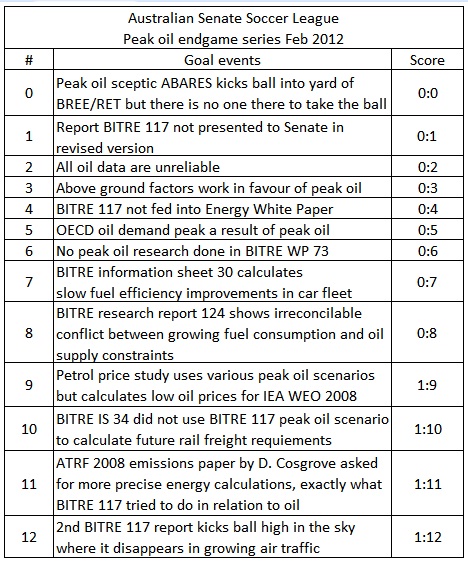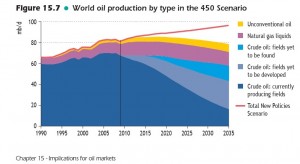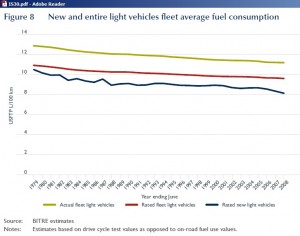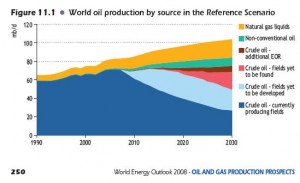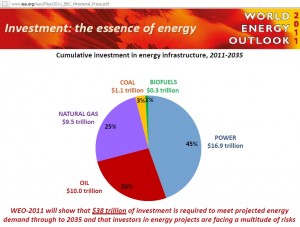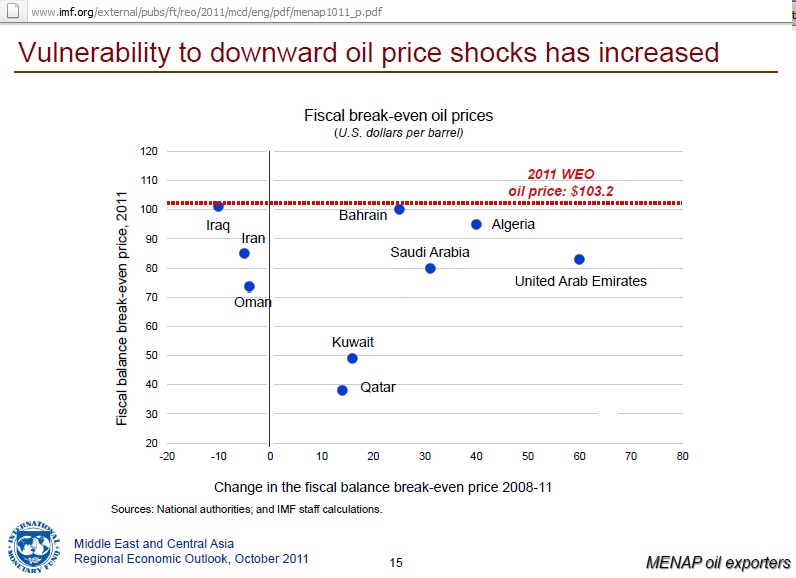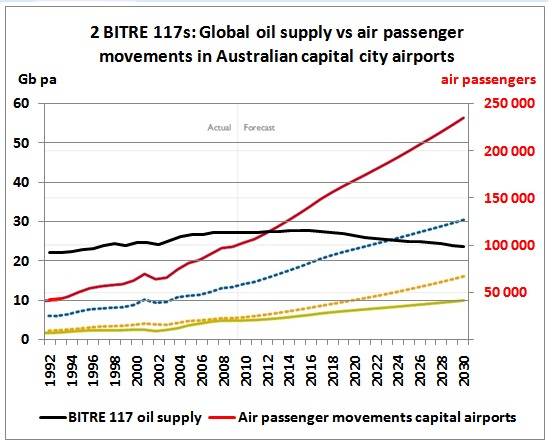Read about the bizarre proceedings during the February 2012 budget estimate hearings in the Australian Senate. Capital Hill in Canberra seemed to be more remote than ever from the reality of oil related conflicts in the Middle East, just a couple of tanker weeks away.
 On 14/2/2012, the opening shots were fired by Senator Edwards (left, standing) >>>
On 14/2/2012, the opening shots were fired by Senator Edwards (left, standing) >>>
and the game ended with a round-up from Senator Ludlam.
Although a leaked government report BITRE 117 on peak oil – comfortably calculated for around 2017 – is freely available on the internet, Minister Kim Carr refused to officially table it before the upper House of Parliament because it was “not up to scratch”. Top bureaucrats said that a peer review showed weaknesses in the methodology of the report, without being able to present readily available written details to the inquiring Senators and without explaining why the report was not re-submitted after considering the criticism in the peer review – which would have been the normal procedure. They also claimed that the report was fed into the Energy White Paper (EWP) process, although the draft of the EWP released in December 2011 neither mentions BITRE 117 nor presents a modified or improved version based on the results of the peer review. It was also argued that there are now a range of other departmental reports which “negate” BITRE 117 and make it even “irrelevant”. It will be shown in this post that – except for one report on fuel prices which uses peak oil scenarios- all other quoted reports neither know about peak oil nor calculate alternatives to BITRE 117. By desperately trying to defend their peak oil denial the government and its top bureaucrats shot a series of own goals.
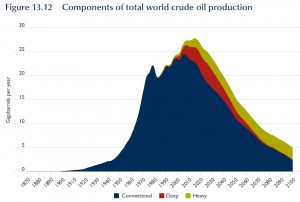 <<The Industry Minister did not want to table this.
<<The Industry Minister did not want to table this.
What’s more, the rather technical focus of the debate on whether the BITRE 117 peak will be in 2017 or not misses equally, if not more important events like the peaking of global crude oil exports already in 2005 and the peaking of oil production in key countries including Egypt, Sudan, Libya, Syria and Iran, to name a few.
List of contents
(1) Australian government does not want public to know about peak oil.
(2) Peer review of BITRE 117 excluded peak oil experts
(3) Methodology and procedure used in BITRE 117
(3.1) Non-conventional sources
(3.2) Reliability of data
(3.3) Above-ground factors
(3.4) BITRE 117 not re-submitted after peer review
(4) BITRE 117 and the Energy White Paper process
(5) Peak oil as zero sum game
(6) Which reports made BITRE 117 “irrelevant”?
(6.1) BITRE working paper 73
(6.2) BITRE Information sheet 30
(6.3) BITRE Research Report 124
(6.4) “Petrol prices in Australia” Dr. Gargett paper
(6.5) BITRE Information sheet 34
(6.6) ATRF 2008 paper on long-term emissions
(7) Irony not shared: 2nd BITRE 117 report lifts off with growing air traffic
(8) ABARES’ peak oil sceptics: less pressure on oil in future
(9) The filter which blocked out peak oil
Conclusion: a long, painful awareness path ahead
Score Table
All extracts in block quote are taken from the Hansard available here:
http://www.aph.gov.au/Parliamentary_Business/Hansard/Estimates_Transcript_Schedule
(1) Australian government does not want public to know about peak oil
Senator LUDLAM: You can table it, Minister.
Senator Carr: The answer is no.
This is the overarching objective of the government’s exercise. The government doesn’t like peak oil and therefore doesn’t want the general public to know about it.
(2) Peer review of BITRE 117 excluded peak oil experts
In the hearing we learn that the report was sent to the International Energy Agency (IEA), the OECD, the German Federal Institute for Geosciences and Natural Resources and a number of “relevant” Australian government departments.
It may be noted that the report was obviously NOT sent to, for example, two independent organisations who routinely work on peak oil estimates:
Prof. Aleklett, President of ASPO
http://www.fysast.uu.se/ges/sv/kjell-aleklett
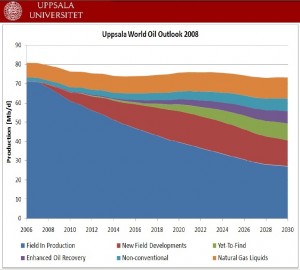 From “The Peak of the Oil Age” (p. 3)
From “The Peak of the Oil Age” (p. 3)
http://www.tsl.uu.se/uhdsg/publications/peakoilage.pdf
Industry Taskforce on Peak Oil and Energy Security
(3) Methodology used in BITRE 117
This is what the report says on its methodology:
“The methodology used in this report is new and allows detailed patterns of future oil production to be forecast from past patterns in oil discovery, when the levels of the discovery data are adjusted to those indicated by past production data.
This adjustment of discovery data (usually upwards) results in higher assessments of possible future production than the so-called ‘peak oil’ analysts.
But it also results in lower forecasts than those from the ‘cornucopians’ as they may be called, who do not see the patterns of current production pointing to a plateau in oil production any time soon.”
This is a modified Hubbert Linearization.
http://www.graphoilogy.com/2007/06/in-defense-of-hubbert-linearization.html
in which future production curves follow adjusted/smoothed discovery curves with an assumed time lag. Usually such estimates produce an upper maximum production envelope, depending on the ultimate assumed discovery.
This is the criticism mentioned in the Senate hearing:
Dr Dolman: ….. However, the referees pointed out that there were a number of weaknesses in the report, things that it did not cover adequately. For instance, according to the referees, it underestimated the influence of oil price and enhanced recovery techniques, which would mean that there would be more oil produced at higher prices than the draft report looked at.
Dr Dolman: ….. The sorts of issues that the referees raised with us were ….. We had underestimated nonconventional sources. We had not taken account of above-ground factors ….. political and physical effects that limit the availability of oil supply from existing resources.
Dr Dolman: There was one other criticism regarding the data used that it was from sources that were not reliable.
(3.1) Non-conventional sources
BITRE 117 had included these non-conventionals: (p 342)
The total production of non-conventional oil accounted for above amounts to 3.5 gigabarrels per year by 2030. The projection of the International Energy Agency (IEA 2006, p97) is for non-conventional oil production to reach 9 megabarrels per day or 3.3 gigabarrels per year by 2030. The Energy Information Administration projects 11.5 megabarrels per day or 4.2 gigabarrels per year (EIA 2006), but this includes coal-toliquids, gas-to-liquids and shale oil.
Well, that is not a big difference and would not have much impact on the timing of a peak between 2010 and 2020. So where is the revised number crunching on this one?
(3.2) Reliability of data
All oil data are unreliable, including those used by the IEA. Since 1998 the IEA is well aware of OPEC’s overstated oil reserves but the IEA estimates just ignore it regardless.
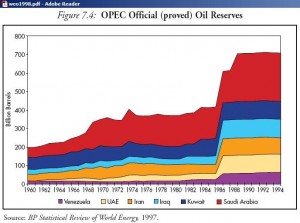 “Because of this large, one-off increase in OPEC’s oil reserves, many commentators have questioned the reliability of the reserves estimates data published in the BP Statistical Review of Energy and the Oil and Gas Journal. They have noted that, while the reserve estimates are described as proven (meaning a greater than 90% probability of being produced), a comparison with the Petroconsultants oil field database suggests that large quantities of probable and possible reserves may have been included in the OPEC estimates. Furthermore, large quantities of unconventional oil also appear to have been included in some OPEC member country estimates, possibly in order to obtain a larger oil production quota.” www.iea.org/weo/docs/weo1998.pdf
“Because of this large, one-off increase in OPEC’s oil reserves, many commentators have questioned the reliability of the reserves estimates data published in the BP Statistical Review of Energy and the Oil and Gas Journal. They have noted that, while the reserve estimates are described as proven (meaning a greater than 90% probability of being produced), a comparison with the Petroconsultants oil field database suggests that large quantities of probable and possible reserves may have been included in the OPEC estimates. Furthermore, large quantities of unconventional oil also appear to have been included in some OPEC member country estimates, possibly in order to obtain a larger oil production quota.” www.iea.org/weo/docs/weo1998.pdf
10 years later, in the WEO 2008, the problem is still unsolved:
“According to BP, which compiles published official figures, proven reserves worldwide have almost doubled since 1980. Most of the changes result from increases in official figures from OPEC countries, mainly in the Middle East, as a result of large upward revisions in 1986-1987. They were driven by negotiations at the time over production quotas and have little to do with the discovery of new resources or physical appraisal work on discovered fields. The official reserves of OPEC countries have hardly changed since then, despite ongoing production” (p.202)
http://www.iea.org/textbase/nppdf/free/2008/weo2008.pdf
The same game still continues:
Oct 5th, 2010: Iraq lifts oil reserve estimates to 143 Gb, overtakes Iran
Only days later:
Oct 12th, 2010: Iran increases oil reserve estimate, passes Iraq
Coming ahead of an OPEC meeting on Thursday, one analyst said the two countries were in a “bidding war” over reserves, which is usually a consideration including other criteria such as production capacity when it comes to allocating quotas.
The BITRE 117 report contains in Appendix A a comparison with other forecasts:
“The issue of differing ultimate recoverable reserve assessments is well illustrated by Figure A3. The three lowest forecasts have ultimate recoverable reserves of about 2500 gigabarrels (assuming 500 gigabarrels of heavy oil). The BITRE forecast is based on about 3000 gigabarrels. and the BGR forecast on 3400. Odell’s forecast is only about 250 higher than BGR at 3650, but he assumes much more is produced more quickly in the early part of the century. CERA makes the same assumption and has a higher still estimate of ultimate recoverable reserves at 4150 gigabarrels (excluding shale oil).”
In its WEO 2010, the IEA writes:
“According to the Oil and Gas Journal (O&GJ, 2009), proven reserves of oil worldwide at the end of 2009 amounted to 1 354 billion barrels — a marginally higher volume than estimated a year earlier and the highest level ever attained. Reserves have more than doubled since 1980 and have increased by one third over the last decade. Half of the increase since 2000 is due to Canadian oil sands reserves; most of the remainder is due to revisions in OPEC countries, particularly in Iran, Venezuela and Qatar. There are continuing question-marks over the estimates for some OPEC countries and their comparability with the figures for other countries. Notwithstanding these uncertainties, OPEC countries account for about 70% of the world total reserves, with Saudi Arabia holding the largest volume” (p. 113)
http://www.iea.org/weo/2010.asp
Given these uncertainties the best way to fine tune peak oil calculations would be to
(a) take the decline rates from the WEO 2008, including the revisions done in 2010
(b) use the additional analysis in the IEA Medium Term Oil Market Reports (published each July), including updated feature articles in the Monthly Oil Market Reports
(c) and stack new oil field production profiles from the Megaprojects data base on top of the declining production
This would have been the job of the Energy White Paper. It was not done
(3.3) Above ground factors
These usually work towards reducing oil production with the potential to increase oil prices or even result in oil supply disruptions. This is the latest example:
19/2/2012 Iran stops oil sales to British and French firms
http://www.reuters.com/article/2012/02/19/us-iran-oil-europe-idUSTRE81I07W20120219
So this was one of the best own goals
(3.4) BITRE 117 not re-submitted after peer review
Senator Carr: …. There are occasions when the peer review demonstrates that a report is really not up to scratch.
Senator Carr: It is a normal process of research that a person will come forward with a proposition, it will be subject to peer review and as a result of that criticism, reports will need to be resubmitted
So why was BITRE 117 not re-submitted if it was not up to scratch?
(4) BITRE 117 and the Energy White Paper process
Mr Mrdak: We produce a number of draft reports which often circulate within government or key agencies and which of themselves might not be published. They then lead to further work…. In fact, the report then fed into work such as the energy white paper and the like that was undertaken for the government.
Let’s see what the Energy White Paper says on peak oil:
“The IEA forecasts that global oil production from conventional and unconventional sources will continue to grow. Physical production limits (so‐called ‘peak oil’) are unlikely to be reached before 2035. However, rising oil prices – from US$78 per barrel (in real terms) in 2010 to US$120 per barrel (in real terms or US$211 in nominal terms) in 2035 – as well as demand‐changing policies and technologies could result in a demand‐induced peak in global production after 2020, depending on the scope of global climate change action. If oil prices remain high, substantial unconventional oil reserves (such as tar sands) may be unlocked to maintain supply. The risk of major supply disruptions remains an unknown but ever‐present factor.”
http://www.ret.gov.au/energy/Documents/ewp/draft-ewp-2011/Draft-EWP.pdf
There is no mention here of BITRE 117 research, how that compares with the IEA World Energy Outlooks and Medium Term Oil Market Reports. Neither are there any numerical calculations to show the differences.
The EWP’s interpretation above is of course a contradiction in itself. If high oil prices were to unlock unconventional oil, then this is not in line with climate change action. It shows that the government is unable or unwilling to handle the simultaneous double challenge of peak oil and global warming.
This graph is from the WEO 2010, the peak is hidden by action to limit CO2 concentration to 450 ppm:
http://www.iea.org/weo/2010.asp
(5) Peak oil as zero sum game
Senator LUDLAM: Is it the view of the bureau that we have come into the age of peak oil or is it still your view that that is some years or decades away? If there is not a view as such then—
Dr Dolman: I do not think we have a firm view. We look at that evidence. There are a number of authoritative publications in this area from the International Energy Agency, for instance, that show that oil production is at least plateauing—
Senator LUDLAM: So, it is no longer doubling, it is plateauing; do you consider that to be—
Dr Dolman: But also the International Energy Agency shows that demand is also plateauing. The growth in demand in China and India, for instance, is being offset by shrinkage in demand for oil within OECD countries.
The demand in OECD countries is declining because of high oil prices – caused by peak oil – and because of these countries involuntarily reducing their consumption. This is an OECD crude oil import graph:
 This demand peak is not voluntary
This demand peak is not voluntary
(6) Which reports made BITRE 117 “irrelevant”?
Mr Williamson: Yes, I believe so. I will ask Dr Dolman to elaborate, but certainly the bureau has undertaken a range of work in the area of transport energy around fuel prices, transport emissions, projections and so on. That work manifests sometimes in formal publications, sometimes in papers delivered at conferences and sometimes in contributions to other processes across government, but it is certainly true to say that we have done considerable work in that area. I will ask Dr Dolman to give you some examples of what we have done.
Dr Dolman: Some examples of the other work that we have done in this area include working paper 73, which looked at greenhouse gas emissions from Australian transport and made projections out to 2020. We have done information sheet 30, fuel consumption by new passenger vehicles in Australia; report 124, road vehicle-kilometres travelled, estimations from state and territory fuel sales. We have a forthcoming report, which will be number 127, looking at traffic growth in Australia. We have also published a number of staff papers principally through the Australian Transport Research Forum by a number of researchers. David Cosgrove has published one on long-term emission trends in Australian transport. David Gargett has published one on petrol prices in Australia, which looks at some of those peak oil issues that you specifically asked about. David Mitchell has published a paper on Australian intercapital freight demand.
Ms O’Connell: It [work on BITRE 117] was back in 2006 to 2008. It was quite some time ago. The report was initially developed and put out for peer review, but subsequent to that there have been other reports that now make it irrelevant.
So let’s go through these reports and see what they say about peak oil and whether they would replace BITRE 117
(6.1) BITRE working paper WP 73
December 2009
Greenhouse gas emissions from Australian transport: projections to 2020
Extracts from this report:
“This report presents the results of a Bureau of Infrastructure, Transport and Regional Economics (BITRE) study into recent trends in transport demand, energy use and resulting emission levels; and provides base case (or ‘business-as-usual’) projections out to 2020 of greenhouse gas emissions from the Australian transport sector.
These projections were prepared at the request of the then Australian Greenhouse Office (AGO)—now the Department of Climate Change (DCC)—and update previous BITRE results provided to the AGO.
The level of future transport sector emissions will probably be strongly dependant on
technological breakthroughs amongst a wide number of ongoing fields of research,
including:
• battery performance and durability, for use in electric and ‘plug-in’ hybrid vehicles
• the treatment of woody waste and other lignocellulose to produce new generation
biofuels
• improvement of solar-photovoltaic conversion efficiency and energy storage, or
otherwise decarbonising the electricity supply—such as by ‘carbon capture and
sequestration’
• fuel cell cost-effectiveness
• the efficiency of hydrogen production using algal photosynthesis, solar-thermal
or other renewable generation sources
Assessing the likely degree of success, timing and scale of any such technical innovations will probably remain quite speculative for some time yet.
The greatest specific uncertainty concerning the base case projections is probably whether there will be any significant disruptions to oil supply during the forecast period, with any consequent increases in fuel prices impacting on transport activity levels.
Further scenarios (e.g. addressing different possible futures, especially depending on potential oil supply constraints or particular implementation of emission abatement policies), though important when considering longer term trends, are beyond the scope of this present study—and would have to be investigated by separate BITRE modelling/ projection studies.” (page xx)
http://www.btre.gov.au/Info.aspx?ResourceId=744&NodeId=16
Hold it, that’s sufficient. No peak oil analysis was done in this report. In fact it states – half year after BITRE 117 was complete – that detailed modelling on oil supply constraints would be required.
The oil prices in Fig 4.2 are of course outdated. They were current in 2007 but to present WP 73 to the Senate – 5 years later – as a report which is now more relevant than BITRE 117 is a stretch.
(6.2) BITRE Information sheet 30
Fuel consumption by new passenger vehicles 1979-2008, August 2009. Extract:
“BITRE has examined trends in the fuel consumption of new passenger vehicles sold in Australia. Up to 2001, technological advances in engine technology, which improved fuel efficiency, were offset by increases in power, weight and the popularity of 4WD vehicles. Since 2001 the overall trend in fuel consumption has continued to decrease with average new light vehicle fuel consumption down 8.4 per cent to 8.14 litres per 100 kilometres (L/100 km).”
http://www.bitre.gov.au/Info.aspx?ResourceId=730&NodeId=21&printable=true
The word “oil” does not even appear in this publication. The above graph shows how slowly average fuel consumption for the whole fleet is declining over the decades. If anything this suggests the problems motorists will face when e.g. petrol rationing is introduced.
Again, a nil return on this one.
(6.3) BITRE Research Report 124
August 2011
Road vehicle-kilometres travelled: estimation from state and territory fuel sales
Historically, Australian businesses and households have had access to inexpensive transport fuel as a result of relatively low global oil prices and low fuel taxes (by international standards). Inexpensive fuels combined with prevalent patterns of urban development have been key factors behind the high level of car ownership and extensive use of trucks for the national freight task.
http://www.btre.gov.au/Info.aspx?ResourceId=810&NodeId=23
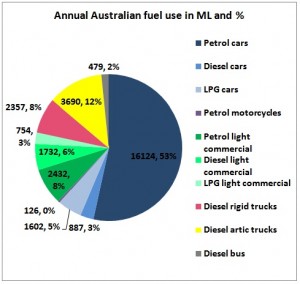 Although this report contains a lot of valuable information, there is no peak oil analysis in this report either. However, for the purpose of calculating the quantities of alternative fuels needed to replace petroleum based fuels for different uses, the following graphs are based on data provided in table TG.9:
Although this report contains a lot of valuable information, there is no peak oil analysis in this report either. However, for the purpose of calculating the quantities of alternative fuels needed to replace petroleum based fuels for different uses, the following graphs are based on data provided in table TG.9:
If anything, the graph shows that growing fuel consumption will clash with constrained fuel supplies.
(6.4) “Petrol prices in Australia”, ATRF Sept 29 – 1 Oct 2010 Proceedings by David Gargett, BITRE
From the abstract:
“The objective of this paper is to model how Australian petrol prices are determined by movements in world oil prices, the Australian exchange rate, and numerous other components of the price chain. This paper examines five scenarios for the future of world oil prices and shows how they would translate into movements in Australian retail petrol prices. The findings suggest that petrol prices are likely to be restrained in this decade. However, in the 2020‟s prices are likely to either rise under peak oil scenarios or continue constrained under the more optimistic world oil supply scenarios.”
Let’s have a look at the scenario “IEA high GDP” where petrol prices stay fairly constant.
The supply side is taken straight from the IEA’s WEO 2008
The GDP growth rate is assumed at 4.5% pa (geometric growth). This is an extract from table 2 on page 7 which shows the data used:
In a graph it looks like this:
The scale for the oil supply (LHS) has been adjusted in such a way that the intersection of the 2 curves is where we are right now. We can see that that GDP lifts off like a rocket compared to oil supplies. The paper then calculates future oil prices by satisfying following equation for each year:
Percentage change oil to GDP ratio =
2.161 – 1.282 * ln(SDR oil-price) + 0.268 * echo variable + 0.717 * postGFCdummy
The oil to GDP ratio and their annual changes are calculated on the basis of the IEA supply scenario and the GDP assumptions. The coefficients on the right hand side of the equation have been obtained from a regression analysis of historical data starting in 1972. The postGFCdummy is only applied to the 3 years 2010-2012. The echo variable peters out over the period to 2030. The most important term on the right hand side is the ln() function applied on the WTI oil price measured in Special Drawing Rights (International dollar)
The table 2 shows the results from solving the equation for the IEA high GDP scenario: the oil price in real 2009 US$ increases from US$ 85 in 2010 to US$ 116 in 2030. These have been obtained by multiplying 1.542 (constant over 20 years) with the respective SDR oil prices of 55 in 2010 and 75 in 2030.
Fig 5 shows a graph for this scenario:
Note that the scale of $600 for the right graph flattens the oil price curve. Nevertheless, the increase is 36% or 1.8% pa., very modest indeed given that a huge gap widens between oil supply and GDP curves. A more detailed analysis of the underlying number crunching would be required but this goes beyond the scope of this post. To be fair to the author, he gives a warning in chapter 7:
“The obvious conclusion: it all depends on what you assume!”
and:
“Increases in the fuel efficiency of the vehicle fleet will be an important factor in mitigating the effects on consumers of any rise in petrol prices, but such increases are very slow given the longevity of the Australian fleet.”
Well, this is exactly what the research in the above quoted BITRE IS 30 has found. But it was not explicitly mentioned to the Senators although this would have been absolutely vital as the assumptions on decreasing oil to GDP ratios require substantial improvements in the overall efficiency of oil use.
In the meantime, a little over a year after the paper was written and as the Senate hearing was going on, the WTI oil price was well above US$ 100. And while writing this post, Tapis was around $130 a barrel
 http://www.bloomberg.com/quote/APCRTAPI:IND/chart/
http://www.bloomberg.com/quote/APCRTAPI:IND/chart/
Tapis oil price graph from Bloomberg 23/2/2012
(a) It is a global model, while actually it should be regionalised. The above spread between WTI and Tapis shows this. The model would have at least to look separately at oil producers, net exporters, net importers, OECD and OPEC as well as Chindia and a group of other developing countries.
The World Bank did it:
GDP impact of oil price shock
Submitted by Theo Janse van Rensburg 2011-06-13
The current turmoil in the Middle East and North Africa has been associated with a $22/bbl increase in oil prices from $90/bbl in December 2010 to $112/bbl by late April 2011 (a 40% increase over the average price of $79.60/bbl in 2010).
In the World Bank’s latest baseline projections, oil prices are expected to gradually decline toward a long-run equilibrium price of about $80/bbl in constant 2011 dollar terms. This implies annual price levels of $107/bbl in 2011 drifting to $96.70/bbl by 2013.
But if current uncertainties persist or a major supply disruption occurs, especially involving larger oil exporters, oil prices could remain high or even rise further, with serious consequences for developing countries and global growth.
Simulations suggest that a further $50/bbl rise in oil prices for one year (beginning in the second half of 2011, for example) could shave off 0.5 and 1.0 percentage points from global output in 2011 and 2012 (see Table 1).
The initial impact of an oil price shock mainly impacts countries through their terms of trade, but it will also raise inflation and interest rates, with the inflation impact (and monetary response) of developing countries likely to be much stronger due to the larger weight of fuel in the consumer basket and/or monetary policy credibility/inflation expectations not as well entrenched as in advanced economies.
Under this scenario, oil exporting countries will see a gain in real income as prices of merchandise exports rise. The income effect will be strongest where exports represent a large share of GDP and the export basket is less diversified (for example in Angola and Nigeria). Oil exporting countries in the Sub-Sahara Africa region and the Middle East and North Africa region could see GDP gains of around 6.6% and 2.4% in 2012, respectively. The oil-importers in Europe and Central Asia will benefit from strong Russian imports.
On the flipside, the economies that will be most negatively affected are the oil-importing countries in the Middle East and North Africa region and the East Asia and the Pacific region, which could see output fall by 2.4% and 1.9% in 2012 respectively, reflecting both the direct effect of higher oil prices on incomes in these regions as well as their greater reliance on exports to other negatively affected oil-importing regions.
GDP declines in oil importers reflect real income declines as the cost of oil and related goods and services rise. This will raise inflation and interest rates, which lowers lower demand, reduces competitiveness, and as a result, output declines. Countries with close economic ties to oil exporters (for example those in Europe and Central Asia) tend to be affected less as they will benefit from higher export demand from oil exporters.
In terms of external balances, current account balances as a share of GDP are expected to rise by up to 6.2% of GDP in oil-exporting Sub Saharan Africa, and by about half that much in the Middle East and North Africa. In East Asia and the Pacific, external balances may decline by about 1% of GDP.
Under the same scenario, high-income oil exporting countries will see a fall in output, largely driven by adverse GDP impacts in Canada and the UK, whose non-oil exports are negatively affected by slowing global demand. Excluding these two countries, the impact on the remaining advanced oil exporters is positive. Also in East Asia and Pacific, the outcome for oil exporters is negative, due to Malaysian non-oil exports being adversely affected by falling global demand (once again, excluding Malaysia, the net GDP impact is positive).
http://blogs.worldbank.org/prospects/gdp-impact-of-oil-price-shock
(b) The debt crisis has many impacts on peak oil. On one hand it will limit economic growth,
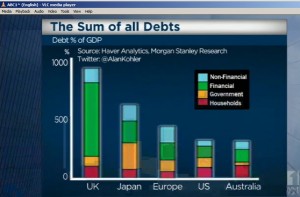 Debt graph from Alan Kohler, ABC TV 7pm news 22/2/2012
Debt graph from Alan Kohler, ABC TV 7pm news 22/2/2012
on the other hand it limits investments in enhanced oil recovery in maturing fields and new oil fields. The IEA warns in its WEO 2011 executive summary:
Global investment in energy supply infrastructure of $38 trillion (in year-2010 dollars) is required over the period 2011 to 2035.
http://www.iea.org/weo/Files/2011_EBC_Ministerial_Press.pdf
(c) Various break even oil prices in different MENA countries are needed to stop social unrest there. This graph is from the IMF:
(d) Oil burden and GDP
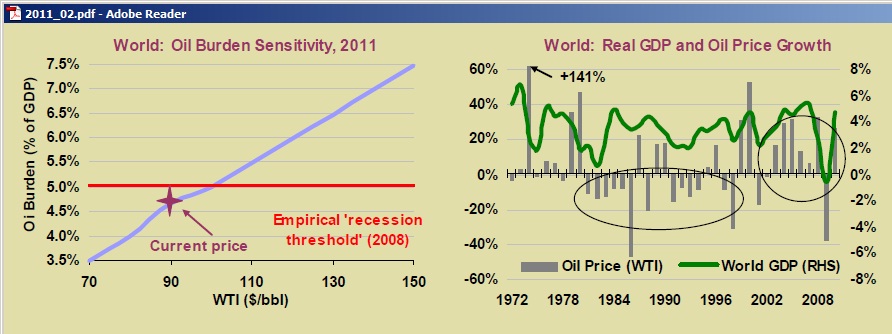
http://omrpublic.iea.org/omrarchive/10feb11full.pdf
When the oil burden in % of GDP exceeds a certain threshold (5%) the economy enters into a recession
In summary: yes, the oil price paper looked at various peak oil scenarios but the low oil prices in at least one scenario were unrealistic
And in the meantime, research has progressed and information must be continuously updated. And while it is notoriously difficult to predict oil prices and it is easy to criticise past papers in hindsight, the point here is that, in February 2012, this and other papers are being presented to the Senate as something which invalidates the BITRE 117 report. This gives a wrong picture. It is white-wash par excellence.
(6.5) BITRE IS 34: Road and rail freight – competitors or complements?
Excerpts:
“The domestic freight task has doubled in size over the past 20 years—averaging growth of 3.5 per cent per annum (see Figure 1(a)). BITRE projections suggest this trend will continue, albeit with slightly slower growth into the future, growing by approximately 3.0 per cent per annum between 2005 and 2030. Over this period, both road and rail freight volumes are projected to more than double, with domestic demand for manufactured goods underpinning much of road freight’s future growth and rail freight growth supported by expected mineral export growth. (The global financial crisis will dampen freight growth in the near term.)” (p 2)
“Until the recent surge in world oil prices, to over US$100 per barrel in 2007–08, road freight was the lowest cost mode for low volume shipments over shorter distances. Ignoring differences between forward and back-haul rates, the average per kilometre road freight cost is more or less constant with respect to distance. Rail generally has lower line-haul costs than road, especially for large volumes and over longer distance, but pick-up and delivery and rail terminal costs add significantly to the average door-to-door cost of rail, particularly for short-haul freight. Consequently, average rail costs decline with increasing freight volumes and distances, such that rail is lower cost for door-to-door freight hauls above 1000 kilometres. With world oil prices averaging almost US$100 per barrel in 2007–08, three times average prices prevailing in 2000–01, however, rail temporarily experienced an absolute price advantage over road across almost all intercapital corridors (ARTC 2008).” 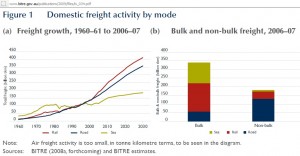
“Where the two modes compete, road and rail freight growth will depend not only on economic activity, but also relative modal costs. ARTC’s $2.1 billion planned investment on the North–South interstate rail line will reduce transit times, improve reliability, increase capacity and reduce ongoing track maintenance costs (ARTC 2008), helping rail compete with road. ARTC (2008) estimates these investments have the potential to double rail’s share to almost 20 per cent of Sydney–Melbourne and Sydney–Brisbane non-bulk freight and 60 per cent of Melbourne–Brisbane non-bulk freight. However, continued investment on the Hume and Pacific Highways will help improve transit times and reduce road freight operating costs, countering somewhat the improvements on rail” (p 11)
“Freight transport input cost trends are likely to be even more influential on future modal competition; most especially fuel prices, since fuel is generally over 30 per cent of total long-distance road freight operating costs—the single largest cost item—and almost 20 per cent of rail freight operating costs. The prospective introduction of greenhouse emission based charges for carbon in transport fuels will likely increase fuel’s share of freight transport costs. In comparison, infrastructure charges are typically less than 5 per cent of total annual road freight operating costs—noting that infrastructure cost are allocated to light vehicles users as well as heavy vehicles—but can be up to 20 per cent of rail operating costs. For oil prices around US$100 per barrel, road freight costs are above door-to-door rail freight costs across all Australian intercapital corridors, including on the shorter Sydney–Melbourne and Sydney–Brisbane intercity corridors. Sustained oil prices at around this level would significantly boost rail’s competitiveness and intercapital modal share.” (p 11)
 http://www.bitre.gov.au/publications/2009/files/is_034.pdf
http://www.bitre.gov.au/publications/2009/files/is_034.pdf
This report was written in the same year as the BITRE 117 report. The freight study does not mention peak oil but is concerned with long-term oil prices above $100, is sympathetic to rail freight development and is therefore one of the better BITRE reports. However, it does not calculate whether fuel efficiency improvements for trucks can offset oil decline, how future diesel prices will impact on the modal share and which rail investments are needed in which timeframe to replace truck based freight, in particular grain freight and food transport to the cities.
Obviously, the authors did not have the task to analyse which impact the BITRE 117 findings on peak oil would have on the freight sector. This example shows there is very little coordination between departments in relation to peak oil.
(6.6) Long term emissions study
Cosgrove, D.C., 2008, ‘Long-term Emission Trends for Australian Transport’, Proceedings of the 31st Australasian Transport Research Forum.
Extract
“Base Case (or ‘business-as-usual’) projections of further growth in transport demand over the medium term (to the 2030 financial year) are also presented – where the current base case or ‘reference’ scenario includes a continuation of current trends in vehicle efficiency improvement, but does not include the possible effects of yet-to-be-introduced emission abatement measures (such as the proposed Australian Emissions Trading Scheme), and assumes that the real price of crude oil over the forecast period averages around that over the 2005 to 2007 financial years (at about $US60 per barrel, in 2006 dollars). (p1)
The reference case projections thus contain quite conservative assumptions regarding future fuel costs, and if the price of oil does not come off the current historical highs, or continues to rise even further, then expected transport growth could be appreciably lowered, even with the relatively inelastic response of most travel to fuel prices. Notwithstanding the possibility of high future fuel costs, the sizeable increases in transport demand, that are quite likely over the coming years, serve as a challenging preface to any discussions concerning which are the best available options for abating transport emissions and mitigating the impacts of transport fuel use on the environment and our communities.(p1)
Over the longer term, global oil demand growth is likely to outstrip the market’s capacity to supply that rate of petroleum production – with many energy sector forecasters expecting the steep projected growth in world future energy requirements to overtake the economically viable level of total petroleum supply before the middle of the century. Further development of some non-conventional sources of oil could also be affected by future climate change policies (e.g. the production of synthetic petroleum from bituminous sands tends to cause even higher CO2 emissions, per unit of production, than for conventional crude oil). (p11)
Such possible oil shortages will have significant implications for future transport task levels, probably before 2050, unless the projected gap between energy supply and demand can be bridged before then; either by increased energy efficiency, or by the large-scale introduction of more-sustainable alternative fuels. Until the form of future oil supply is more precisely known, energy use projections longer than about a 2030 timeframe should be considered as highly speculative – and where even the (conservative) oil price assumptions adopted here, for the years up till 2030, have a significant level of uncertainty attached to them. (p11)”
Obviously, the graph with increasing petrol and diesel consumption is in conflict with the “significant level of uncertainty” in oil prices until even 2030. But what is most important in the context of the Senate hearing is that this study calls for “more precisely known energy use projections”. The Cosgrove study was presented at the 31st ATRF in October 2008, shortly after the oil price spike in July 2008 and just as the GFC was bringing oil prices down. The BITRE 117 report was in its final draft stages at that time before it was completed (or interrupted?) in March 2009. It did exactly what was asked for in the emissions study. So to argue now, in February 2012, that the Cosgrove study invalidates BITRE 117 is in contradiction with the facts and not in line with the actual sequencing history of these reports.
(7) Irony not shared: 2nd BITRE 117 report lifts off with growing air traffic
Senator LUDLAM: The irony is when you Google report 117, which I did just as Senator Edwards was speaking, you come across a paper on aviation. So the 117 that was eventually published was about aviation.
Mr Williamson: That is correct.
Senator LUDLAM: I presume if I look at the conclusions of that report out to 2029-30 it will say that aviation is just going to double and then double again presumably out to that period. Does anybody else at the table share the irony that the report into supply constraints never got published; the report into never-ending expansion of aviation ended up being report 117?
Mr Mrdack: I do not think anyone shares your notion of irony, because I do not think that is an accurate representation of what the research is saying.
Senator LUDLAM: What is the research saying?
Mr Mrdack: I think if you have a look at the projections that have been done on aviation demand, they are being modelled on the best projections available of supply and demand of oil. Also, as Dr Dolman said, alternative fuel sources and technologies are coming into the market.
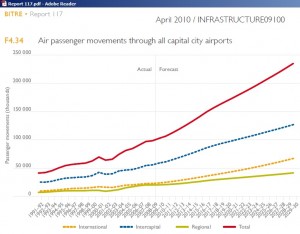 http://www.bitre.gov.au/publications/55/Files/Report%20117.pdf
http://www.bitre.gov.au/publications/55/Files/Report%20117.pdf
OK, let’s superimpose the 2 BITRE 117 reports:
Again, the scale for oil supplies is adjusted so that the oil supply curve intersects the passenger movement curve where we are now. The diverging curves are clearly visible.
(8) ABARES’ peak oil sceptics: less pressure on oil in future
A day earlier, on 13/2/2012:
Senator MILNE: Thank you very much, Chair. I want to ask ABARES about climate variability and peak oil and any work that you have been doing on impacts on food security, either nationally or globally, and what your latest work in this area is revealing.
Dr Ritman: Senator, just to clarify your question, you said ‘climate variability’. Do you mean climate change as well there?
Senator MILNE: Yes, climate change producing or adding to variability. Also, I know there is a new division that has been set up in RET to deal with peak oil. Nevertheless, oil and agriculture and climate variability exacerbated by climate change is a big issue globally. I want to know what ABARES’ assessment of that is, what you are factoring in terms of Australian food production, food security, and in the global context. You could write a book on it, I know.
Mr Glyde: I was just going to clarify, just to be clear about what we have responsibility for talking about. The issue of peak oil itself is a matter that would now be dealt with by the Bureau of Resource and Energy Economics in the Department of Resources, Energy and Tourism, so they would be, thankfully, the people to answer questions in relation to peak oil and what have you. I think what you are after is: are we, ABARES, doing any analysis that takes into account things like peak oil in looking at food security?
Senator MILNE: Yes, peak oil and the work you are doing on climate variability exacerbated by climate change on that very issue.
Dr Ahammad: We have not undertaken any study, as such. What we are doing at this stage is linking with an international forum called AGAPE, which is looking into modelling of similar issues. We are just taking part in the initial endeavour in this modelling exercise.
Senator MILNE: So, given you are giving the agricultural community in Australia advice as to predicting where things are going to go, what advice are you giving people currently in relation to peak oil, the information you are getting from the bureau? How are you interpreting that in terms of the advice you are putting out from ABARES? What is your current analysis of that advice?
Mr Morris: We have been a little sceptical about peak oil for some time, in any case, but at this stage we are not specifically looking at that. As you may be aware, the peak of the peak oil has been consistently moving out into the future because of new discoveries and new ways of actually extracting oil. Also there is obviously increased competition from other energy sources now, which also means that there may be less pressure on oil in the future.
Got that: less pressure on oil in future? But BREE writes something else in its Dec 2011 publication “Australian Energy Projections to 2035”, although there is nothing on peak oil:
“Projections of declining oil production and constraints around petroleum refining suggest Australia’s net trade position for crude oil and refined petroleum products will weaken over the projection period, with net imports projected to increase at an average rate of 3.1 per cent a year.”
“Oil
In 2010, oil prices in WTI terms averaged around US$79 a barrel. World oil prices are projected to remain around real US$90–95 a barrel over the medium term, as oil demand increases in line with assumed stronger economic growth. The availability of spare production capacity and stocks in OPEC are expected to limit significant increases in oil prices over the medium term.
The long-term prospect for oil prices is much less certain. Key factors that are expected to drive long-term oil prices are the cost of developing remaining oil reserves, the volume and timing of investment in production and refining capacity, and technological development in relation to alternative liquid fuels. The estimated capital and production costs for conventional oil sources have increased in recent years because of rising materials, equipment and labour costs. While a rise in the marginal cost of oil production is expected over time, technological developments associated with non-conventional liquids, such as gas-to-liquids and second generation biofuels, have the potential to play a major role in anchoring oil prices below what would have been the case without these new technologies. However, it is not expected that these technologies will be developed in Australia. The assumed development and entry of these technologies underpins the long-term price assumptions used in this report.”
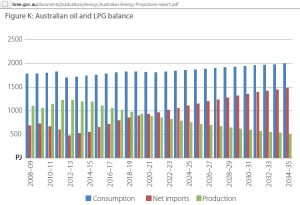 http://bree.gov.au/documents/publications/energy/Australian-Energy-Projections-report.pdf
http://bree.gov.au/documents/publications/energy/Australian-Energy-Projections-report.pdf
The report doesn’t mention that “oil” contains a lot of condensate which cannot be used in Australian refineries. And here is another quote from “Resources and Energy Quarterly Reviews” (Sept 2011 quarter)
In conclusion, changes in the prices of resource and energy commodities depend on the interactions between demand and supply in both the short and the long run. Positive demand shocks, particularly from emerging economies like China and India due to their rapid economic growth, combined with a slow supply response for many commodities, explains most of the upward price trends for mineral and energy commodities since 2003. While we expect greater supply responses in the coming decade, high resource commodity prices will continue, at least for the foreseeable future, and will provide large benefits to resources and energy exporting countries such as Australia.
http://bree.gov.au/documents/publications/BREE_REQ_Sept11_ResourcesEnergyPrices.pdf
So the focus is on the “demand shock” for Australia’s iron ore and other minerals but the supply shock for an oil net importer like Australia is not seen because the energy exports of coal and LNG hide Australia’s oil import problem.
So ABARES kicks the peak oil football into the yard of RET but no one is there to take the ball. As is shown in this post, there are numerous inconsistencies between various government reports but they all have one thing in common: except for the petrol price paper by Dr. Garrett there is nothing there on peak oil.
(9) The filter which blocked out peak oil
Senate estimate hearings, Monday, 13th Feb 2012
Senator LUDLAM: Can you tell us about the filter that operates in this building? Maybe this is something that we will handball to the reviewer, but can you tell us at the moment the extent to which computers on the parliamentary network are filtered for MPs and staff?
Mr Kenny: What you mean by ‘filtered’?
Senator LUDLAM: As I am aware, the entire top-level domain .info is blocked from within this building. On three separate occasions in the last fortnight I have had to ring tech support to unblock a website—an antiwar website, a peak oil website and something to do with nuclear disarmament—because they were in the .info domain. My understanding is that that entire domain is blocked to residents of this building. Is that correct?
Mr Kenny: That is correct. That was done for security reasons based on advice from government.
…….
Senator LUDLAM: Do you know how many websites in that domain in total are blocked?
Mr Kenny: I do not know.
Senator LUDLAM: Is that something that you would be able to find out for us? I spent two years campaigning against an internet filter for the general population only to discover that now I am one of the only people in the country who is filtered, which is a little but alarming. I am just trying to get a sense of the scope of it.
Mr Kenny: We can try and find out. I do not know whether that information is able to be found, but we can try. When I say ‘able to be found’ I mean whether there is a place where all .info sites are registered and whether we can make an inquiry. Without getting too technical, in my mind I would certainly draw a distinction between filtering, which is content based, and security blocking, which is blocking something that is considered to be a threat to the security of the network.
Senator LUDLAM: A website about peak oil?
Mr Kenny: I am sorry, I am just drawing the distinction between the filtering. It is something quite different. We do have a filter, which operates in a completely different way.
……
Here you are, the government doesn’t even check the websites they are filtering or blocking, for example this one?
NSW City Rail http://www.cityrail.info/
Well, MPs never seem to take the train.
Conclusion:
It is crystal clear that the current government and top officials in various departments are in no mood to deal with peak oil. Therefore – using a quote from the internet – peak oil will deal with them, err.. with us. Unfortunately, we need to wait until either skyrocketing oil prices or physical shortages at filling stations wake up the general public to make peak oil an election issue. It will then be too late to prepare for declining oil production.
Outlook
We are now in the initial stages where some voices call for more ethanol or the climate nasties like coal-to-liquids (Alan Jones). Other calls will follow: green cars, yellow cars and electric cars. Everyone will forget the trucks which bring food to our cities. But when that is realised attention will turn on natural gas as transport fuel. Don’t we have this stuff for decades to come? People will discover that the “easy” gas has been locked up in long term supply contracts to foreign countries. So this is one scenario the public awareness discovery path has to go through, an arduous and painful process with many dead-end streets (like hydrogen cars).
And by the time our politicians are forced to act it will be found that we should have started to implement public transport and rail freight solutions at least 10 years ago (instead of going to war in Iraq). The only hope we have now is that the media speeds up this awareness process and finally starts to continually inform the public about peak oil and its solutions.
———-
Note:
Cosgrove, D.C., 2008, ‘Long-term Emission Trends for Australian Transport’, Proceedings of the 31st Australasian Transport Research Forum.
was neither available on the BITRE nor the ATRF website
http://www.atrf.info/papers/index.aspx (also a .info web site!)
at the time of writing this article. Just hours after publishing the post, the PDF was made available with thanks by Infrastructure Australia. Therefore, chapter 6.6 had to be added and the score table was amended.
